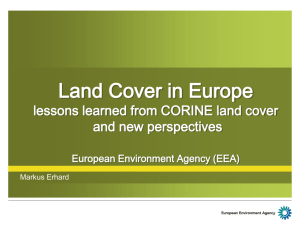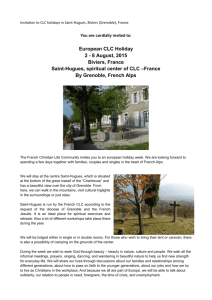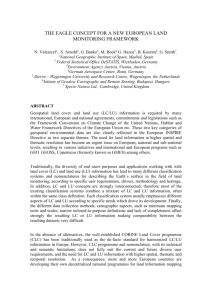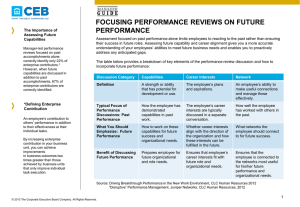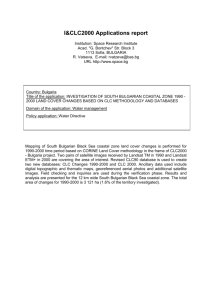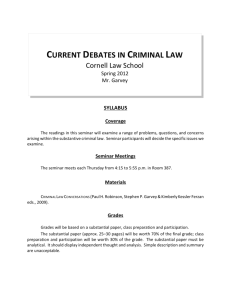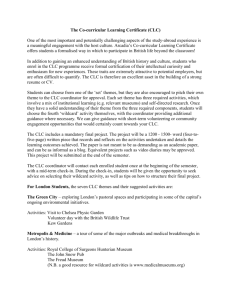Renate Koeble & Adrian Leip, Ispra: Disaggregation of CAPRI results
advertisement
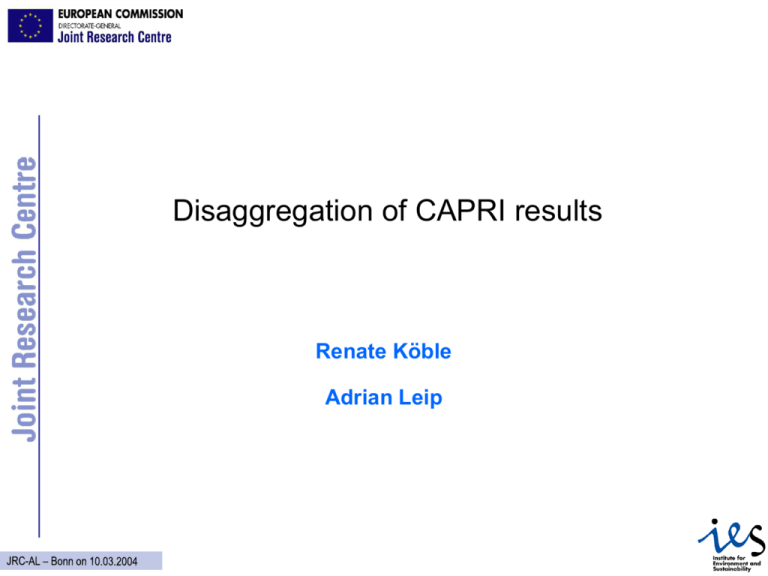
Disaggregation of CAPRI results Renate Köble Adrian Leip Outline 1. Introduction 2. Existing approaches 3. Tentative solution of the problems 4. Overview on available data sets → → Corine Landcover 2000 LUCAS survey 7. First example WP8 - CAPRI-GIS link “Link of CAPRI to GIS covering soil, climatic and land use maps” Distribution of agricultural activities on the land → Correspondence between geo-coded data and geo-referenced data from land cover maps Distribution of secondary agricultural parameters → → → → livestock densities, feed composition animal wastes (grazing / stabling / application)? mineral fertilizer other parameters? Re-mapping for the calculation of indicators → grid size / thematic maps Allocation of land use changes in the reference year → → net / gross changes ? use of additional information Studies to built on ... (1) Trees species map (Renate) Calculation of Agricultural Nitrogen Quantity for EU River basins (JM Terres, JRC, 2000) → based on a methodology developed in a regional study (Loire and Elbe catchment) 2000 → used by Declan to disaggregate NUTS 2 NewCronos data to NUTS 3 level for the DNDC model Use of a correspondence table Corine / FSS CORINE NUTS 2 allocation matrix NUTS 3 (or gridcell) VARESE PROVINCE Land to be redistributed (FSS 2000 - arable land (D except rice)) → → Lombardia Varese 641 640 ha arable land 6 440 ha arable land Land available (Corine Land Cover 90) → → → class 211: non-irrigated arable land class 242: complex cultivation pattern class 243: land principally occupied by agriculture Lombardia Varese 211 242 Corine Land Cover Area [1000 ha] 856 36 13 0 243 94 12 x distribution factor for potentially available land: Lombardia Varese • non-irrigated arable land 0.95 • complex cultivation pattern 0.80 • land principally occupied by agriculture 0.60 Land available for FSS class arable land 813 22 56 12 0 7 2.2% of land potentially available in Lombardia is located in the province of Varese 891 19 Disaggregation FSS2000 data Varese Como Lecco Sondrio Milano Bergamo Brescia Pavia Lodi Cremona Mantova 2.2% 1.5% 1.0% 1.5% 11.0% 7.6% 17.3% 13.3% 7.1% 16.4% 21.2% 13805 9745 6566 9902 70337 48449 110789 85456 45827 104922 135842 Varese Como Lecco Sondrio Milano Bergamo Brescia Pavia Lodi Cremona Mantova 1.0% 1.1% 0.5% 0.2% 8.9% 6.1% 18.3% 14.1% 7.2% 18.9% 23.8% 6440 7020 3220 1470 56870 38830 117190 90630 46510 120980 152480 Lombardia 100% 641640 Lombardia 100% 641640 → → → Total deviation: 45 000 ha (7% of total arable land distributed) “Transfer” of arable land from the south to the north total potential area: 891 kha LOMBARDIA Non-irrigated land Permanently irrigated land Complex cultivation pattern Land principally occupied by agriculture with sign. areas of natural veg. Natural grassland Pastures Agro-forstry Fruit trees and berry plantations Rice Fields Vineyards Forests Water Urban Problems? → Assumption of equal land use of land classes throughout Europe → → → Non-matching between statistical and land cover data Interpretation errors and interpretation differences Time lag between Satellite images and Statistical census • Corine 1990 has is based on images between 1985-1993 • FSS 2000 represents the situation in 2000 Studies to built on ... (2) Spatial redistribution of statistical data from the Farm Structure Survey (GIM report) → → → → → Match absolute values of land in both data sets regrouping of CLC and FSS to aggregate classes Matrix of land cover classes potentially available Classes are filled-up successively Coefficients are optimized Aj i c ij CLC i Aj: area of Farm Structure category j CLCi: area of Corine class i cij: coefficient for redistribution of Corine class i to FSS category j GIM approach SOIL MAP, DEM NUTS 2 allocation algorithm CORINE NUTS 3 (or gridcell) Ranking of differences FSS-CLC → for all classes except rough grazing successive determination of coefficients • Determination of the fraction of temporary pasture to be distributed to permanent pasture: • when CLC overestimates arable land together with an underestimation of pasture, the possibility to allocate part of (211+212) to (231) up to a max. of 25% is evaluated • Distribution of complex classes Redistribution of complex classes recalculation of FSS and CLC by using coefficients y GROUP or CLASS FSS original CLC class additional CLC classes coeff. CLC coeff. CLC coeff CLC 1 arable land without rice fields D + G05 - I05A - I05B - D07 - aD18 b1 211 + 212 c1 242 d1 243 2 rice fields D07 b2 213 c2 242 d2 243 3 vineyards G04 b3 221 c3 242 d3 243 G01 + G02 b4 222 c4 242 d4 243 5 olive groves G03 b5 223 c5 242 d5 243 6 permanent pasture F01 + Ad18 b6 231 c6 242 d6 243 7 rough grazing F02 d7 243 4 fruit trees and berry plantations b7 or f7 231 or 321 8 combined crops; permanent and annual I05B + E b8 241 c8 242 d8 243 9 combined crops; annual and forestry I05A b9 244 c9 242 d9 243 Interaction of permanent pasture and rough grazing if FSS (pasture) is bigger than CLC (pasture) → the coefficient “a” for allocating part of temporary pasture (D18) to permanent pasture (F01) will be evaluated • • • if F01 < class 2.3.1. up to a maximum value of “a” that FSSarable CLCarable up to a maximum value of “a” that FSSarable CLCarable recalculation of FSS and CLC by using coefficients y GROUP or CLASS FSS 6 permanent pasture F01 + aD18 7 rough grazing F02 original CLC class coeff. b6 additional CLC classes CLC 231 b7 or f7 231 or 321 c6(242) + d6(243) + e6(211+212) + f6(321) + g6(322) + h6(323) + i6(333) d7(243) + g7(322) + h7(323) + i7(333) Parameters used for tuning → → class 2.4.2. (complex cultivation pattern) • a minimum of 25% must be used for “pasture” class 2.4.3. (Land principally occupied by agr. with sign. areas of natural vegetation) → • a maximum of 75% can be used to match agricultural land. • the share of natural vegetation can be used to match rough grazing Maximum tolerable error at district-level • the matching of FSS and CLC can be stopped if the error is <3%, when the addition of new classes makes the distribution too uncertain → class 2.1.1. • a maximum of 25% can be used to match pasture land Problems Assuming pure classes → also pure classes have a proportion of other land uses Assumptions on coefficients and sequence arbitrary → methodology will have to be re-checked Geo-referencing with soil map and digital elevation model → probabilities for aggregated classes only Time difference between data sets → “buy” synchrony with statistical consistency “Solution” Use of updated data → → “Corrected” Corine 1990 landcover map Corine 2000 land cover map as it becomes available Use of LUCAS to determine probabilities of a certain land use in a land cover class → → → clustering of LUCAS points co-location problems derive matching function between Corine and LUCAS land cover classes Use of physical parameters → determine relationships between the occurrence of • • disaggregated arable classes and soil (texture, chemistry), climate (temperature, precipitation, vegetation period), elevation (absolute elevation, slope) Co-location problem Gallego, 2003 Proposed approach NUTS 2 LUCAS SOIL MAP, DEM, climate allocation map+algorithm CORINE GRID What is the target grid / map ? Nested approach for DNDC? → → → 5 or 10 km grid landscape assessment: complexity of landscape 2.5 or 1 km grid Other maps according to the results of WP9 →Catchments ? →homogeneous units ? 1.3·106 km2 x 1 min = 2.5 years CAPRI Definition of parameters to be disaggregated WP8 Allocation of land use into the land cover map WP9 CAPRI-indicators CAPRI-indicators disaggregated (grid) disaggregated (map) WP10 Definition of target scale and target map WP10 WP9 Simulation of nutrient cycling Landscape assessment indicators
